


xxxxxThe Englishman John Wesley
was ordained in 1728. On returning to Oxford as a tutor, he and his
brother Charles were members of the Holy Club, a group of so-
JOHN WESLEY 1703 -
THE FOUNDATION OF METHODISM
Acknowledgements
John Wesley: by
the English portrait painter George Romney (1734-
G2-
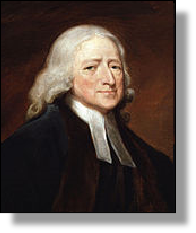 xxxxxJohn Wesley, the founder of Methodism, was
born in Epworth, Lincolnshire, where his father was the rector. He
attended Charterhouse School before going up to Christ Church, Oxford,
in 1720. He was ordained in the Church of England in 1728, and the
following year returned to Oxford as a fellow of Lincoln College. It
was here that, together with his brother Charles and, later, his
friend George Whitefield, he was a member and then leader of the Holy
Club, a group of religious-
xxxxxJohn Wesley, the founder of Methodism, was
born in Epworth, Lincolnshire, where his father was the rector. He
attended Charterhouse School before going up to Christ Church, Oxford,
in 1720. He was ordained in the Church of England in 1728, and the
following year returned to Oxford as a fellow of Lincoln College. It
was here that, together with his brother Charles and, later, his
friend George Whitefield, he was a member and then leader of the Holy
Club, a group of religious-
xxxxxIn 1735, together with his
brother Charles and the evangelist George Whitefield, he travelled
as a missionary to Georgia, the colony only recently established by
James Oglethorpe in North America. Save for his meeting with some
German Moravians, who impressed him with their piety and spiritual
peace, the trip was a disaster. His high church views were not well
received, and his missionary work among the Indians met with
failure. He sailed back to England in December 1737, a disappointed
man, but in May the following year, while attending a Moravian
service in London, his "heart was strangely warmed" and he
experienced what he described as his conversion to evangelism. This
"Aldersgate Street Experience", as he later termed it, convinced him
that his mission was to preach the simple message that a person
could be saved by faith alone. This dictum being opposed by a large
number of Anglican clergy, the following year he joined in the work
of the evangelist George Whitefield, and Methodism was born. In a
very short time he had gained a reputation throughout the country
for the passion and fervour he brought to his open-
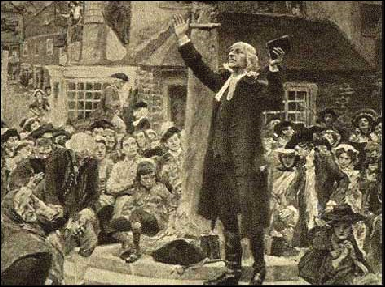 xxxxxOver the next
fifty years he rode across the country on horseback, reaching out to
the masses and converting thousands to the Christian faith by his
simple, direct message. It is estimated that he travelled some 5,000
miles each year and gave an average of four sermons a day. The sermons
he gave on these occasions, together with his notes on the New
Testament, formed the basis of the Methodist doctrine. Hisxtheology
was greatly influenced by A Serious Call to a
Devout and Holy Life, the work of the
English cleric William Law (1686-
xxxxxOver the next
fifty years he rode across the country on horseback, reaching out to
the masses and converting thousands to the Christian faith by his
simple, direct message. It is estimated that he travelled some 5,000
miles each year and gave an average of four sermons a day. The sermons
he gave on these occasions, together with his notes on the New
Testament, formed the basis of the Methodist doctrine. Hisxtheology
was greatly influenced by A Serious Call to a
Devout and Holy Life, the work of the
English cleric William Law (1686-
xxxxxThe early success of this spiritual revolution clearly called for the setting up of a nation wide organisation. As early as 1739 the first Methodist society was formed in London, and its eventual meeting place, a building called the Foundry, became the headquarters of the movement for many years. Societies then began to be set up throughout the country. In 1742 these societies were themselves divided into districts and circuits, many led by lay preachers, and two years later the first conference of Methodist leaders was held, and this became an annual event. By this time, however, the movement had begun to form its own specific doctrine. This had led to a split with the Moravians and with George Whitefield, a Calvinist who believed in the doctrine of predestination.
 xxxxxBut the Methodist movement remained within
the Church of England for some years ahead, despite Wesley's rejection
of the apostolic succession. Indeed, it was not until 1784 that the
separation became virtually inevitable. It was then that he issued a
Deed of Declaration, a legal constitution setting out the guidelines
to be followed by the societies, and in the same year he himself
ordained his aide, Thomas Coke, for service in the United States. When
this was followed by other "ordinations" the break with the Anglican
church was just a matter of time. It came in 1795, four years after
Wesley's death, when the Methodist Conference authorised their
preachers to administer the sacraments even though they had not been
ordained by the Church of England. This proved a step too far.
xxxxxBut the Methodist movement remained within
the Church of England for some years ahead, despite Wesley's rejection
of the apostolic succession. Indeed, it was not until 1784 that the
separation became virtually inevitable. It was then that he issued a
Deed of Declaration, a legal constitution setting out the guidelines
to be followed by the societies, and in the same year he himself
ordained his aide, Thomas Coke, for service in the United States. When
this was followed by other "ordinations" the break with the Anglican
church was just a matter of time. It came in 1795, four years after
Wesley's death, when the Methodist Conference authorised their
preachers to administer the sacraments even though they had not been
ordained by the Church of England. This proved a step too far.
xxxxxThroughout his life as a
preacher Wesley showed a deep concern for the advancement and well-
xxxxxHe died in March 1791, and was buried in the graveyard of City Road Chapel in London. A memorial plaque to him was placed in Westminster Abbey, a clear indication that, by that time, much of the heat had gone out of the hostility once shown to him by high church members of the Church of England. At his death it was estimated that converts to his faith numbered 70,000.
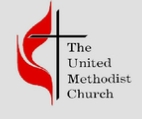 xxxxxMethodism today has some 40 million members
worldwide, the largest number being in the United States, where a
separate church was founded in 1784. A number of doctrinal disputes
caused divisions in the 19th century, but these were reconciled at a
conference in London in 1932, when the Wesleyan, Primitive and United
Methodists were formed into the Methodist Church. In its early years
in particular, the movement provided spiritual comfort for large
numbers of working-
xxxxxMethodism today has some 40 million members
worldwide, the largest number being in the United States, where a
separate church was founded in 1784. A number of doctrinal disputes
caused divisions in the 19th century, but these were reconciled at a
conference in London in 1932, when the Wesleyan, Primitive and United
Methodists were formed into the Methodist Church. In its early years
in particular, the movement provided spiritual comfort for large
numbers of working-
xxxxxCharles Wesley (1707-
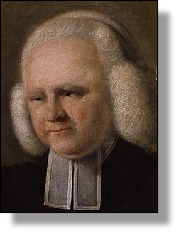 xxxxxThe English
evangelist George Whitefield (1714-
xxxxxThe English
evangelist George Whitefield (1714-
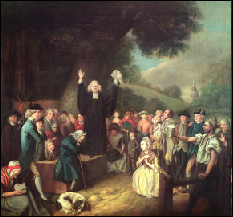 xxxxxJohn Wesley joined Whitefield as an
itinerant preacher in 1739, and, together, they turned the Methodist
movement in the British Isles into something of a spiritual
revolution. But the working relationship between the two men was not
destined to last. Whitefield was a Calvinist, believing in
predestination, whereas Wesley held the views of the Dutch Protestant
Jacobus Arminius, a man totally opposed to this doctrine. In about
1741 they parted company, though they remained friends. After this
break, Whitefield became recognised as the leader of the Calvinistic
Methodists. He died in 1770 whilst on one of his preaching tours in
the American colonies. It is said that during his career he preached
more than 18,000 sermons.
xxxxxJohn Wesley joined Whitefield as an
itinerant preacher in 1739, and, together, they turned the Methodist
movement in the British Isles into something of a spiritual
revolution. But the working relationship between the two men was not
destined to last. Whitefield was a Calvinist, believing in
predestination, whereas Wesley held the views of the Dutch Protestant
Jacobus Arminius, a man totally opposed to this doctrine. In about
1741 they parted company, though they remained friends. After this
break, Whitefield became recognised as the leader of the Calvinistic
Methodists. He died in 1770 whilst on one of his preaching tours in
the American colonies. It is said that during his career he preached
more than 18,000 sermons.
xxxxxIncidentally,
Whitefield was cross-
Including:
Charles Wesley
and
George Whitefield

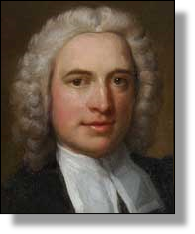 xxxxxAs we have seen, Charles
Wesley (1707-
xxxxxAs we have seen, Charles
Wesley (1707-
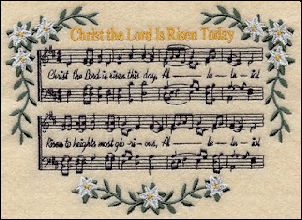 xxxxxCharles accompanied his brother to Georgia
in 1735, having taken holy orders in order to work as a missionary. On
arrival he acted as secretary to the colonial governor James
Oglethorpe, but the climate proved too much for him, and he returned
home within a few months. When Methodism began to expand in the 1740s,
he took an active part as an itinerant preacher, notably in London and
Bristol, but he was most anxious to keep the movement within the
Church of England, and strongly disapproved of John's ordination of
"clergy" for work in America. This, plus disagreement over family
matters, led to some measure of estrangement between the two brothers,
and in the late 1750s he began to take a smaller part in the
leadership of the movement.
xxxxxCharles accompanied his brother to Georgia
in 1735, having taken holy orders in order to work as a missionary. On
arrival he acted as secretary to the colonial governor James
Oglethorpe, but the climate proved too much for him, and he returned
home within a few months. When Methodism began to expand in the 1740s,
he took an active part as an itinerant preacher, notably in London and
Bristol, but he was most anxious to keep the movement within the
Church of England, and strongly disapproved of John's ordination of
"clergy" for work in America. This, plus disagreement over family
matters, led to some measure of estrangement between the two brothers,
and in the late 1750s he began to take a smaller part in the
leadership of the movement.
xxxxxIncidentally, his son Samuel was a composer and an accomplished organist. He wrote church and secular music and, like his father, produced a number of hymns.
xxxxxThe English evangelist George Whitefield (1714-


